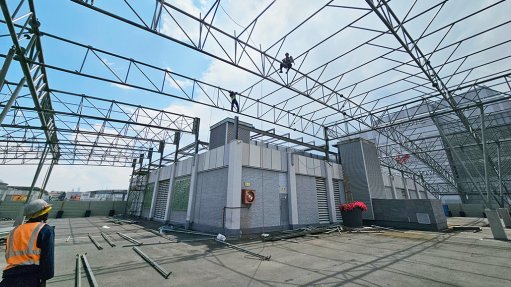
BUILDING INTO THE FOUNDATION
The concrete columns that secure the steelwork have to be drilled and dowelled onto the existing columns supporting the rooftop slabs, transferring the weight to the centre’s foundations
Photo by: Concor
The addition of another 5.74 MW of solar power at Eastgate Shopping Centre, east of Johannesburg, is being undertaken by diversified infrastructure and construction company Concor, while keeping the movement of tenants and shoppers unaffected.
The solar panels to generate this power will cover 30 000 m2 of the centre’s rooftop, according to Concor contract manager Martin Muller. This has meant careful planning of the sequencing of the project and management of traffic to minimise any disruption, states Muller.
“We are conducting the project in stages so we limit work to one confined area at a time, leaving as much parking available to shoppers as possible. We also meticulously manage the traffic flow to ensure convenience and safety,” he explains.
The location of the solar panels on the rooftop has presented various challenges to the construction process, with the low load-bearing capacity of the rooftop parking area negating the use of cranes and ready mix trucks.
This requires Concor to use small dumpers for the transporting of concrete. It also required specially designed scaffolding to accommodate conveyors carrying concrete into the column formwork.
The weight of the structural steelwork underpinning the large domes of solar panels is significant.
This has meant that the concrete columns that secure the steelwork have to be drilled and dowelled on to the existing columns supporting the roof top slabs, transferring the weight to the centre’s foundations.
This requires the careful scanning and opening up of the column heads, to avoid any damage to the post-tensioned cables.
Muller explains that the risk of the solar panel structure being lifted by high winds is also a factor that has to be considered during construction; one that necessitates that the dowels have a pull-out strength of 12 t – or 120 kN – each. These are tested to ensure compliance with the specification.
He notes that, to speed up the project, the steel girders and trusses were premanufactured and thus ready for installation. “The specific configuration of each dome was determined by the position of the concrete stub columns, so this demanded accurate design parameters for the manufacturing and installation of the steelwork,” he concludes.